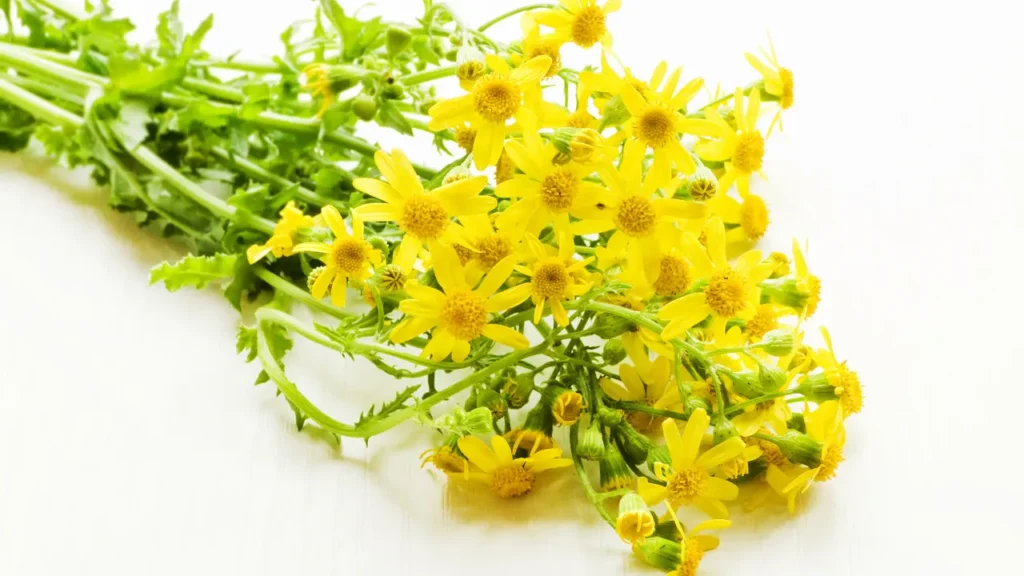Alpine Ragwort (Senecio alpinus) is a herbaceous perennial plant in the Asteraceae family. The plant is native to the European Alps and is distinguished by dense clusters of yellow flowers and serrated, lanceolate leaves. Although Alpine Ragwort has long been used for its therapeutic benefits, scientific research and findings on this plant species are limited. The purpose of this article is to investigate the nature, health benefits, appropriate dosage, side effects, potential substance interactions, and safe usage of Alpine Ragwort as a nutritional supplement.
You May Also Like:
What Are the Best Mushrooms for Brain Health? Here Are the Facts.
5 Things to Consider When Choosing the Best Mushrooms for Mental Health
ALPINE RAGWORT: Benefits, Dosage, Side Effects, Drug Interactions, and Other Important Information is an original (NootropicsPlanet) article.
Nature of Alpine Ragwort
Numerous bioactive substances, such as flavonoids, alkaloids, and sesquiterpene lactones, are present in Alpine Ragwort. The anti-inflammatory, anti-tumor, and anti-microbial characteristics of the latter family of chemicals have been the subject of research. Alpine Ragwort contains a significant amount of alpina, a sesquiterpene lactone with powerful anti-inflammatory and anti-cancer properties.
Health Benefits of Alpine Ragwort
Inflammatory-reducing qualities
Sesquiterpene lactones are shown to suppress the expression of pro-inflammatory cytokines like interleukin-1 (IL-1), interleukin-6 (IL-6), and tumor necrosis factor-alpha (TNF-alpha). They are responsible for Alpine Ragwort’s anti-inflammatory properties. These cytokines play a role in the pathophysiology of numerous inflammatory disorders, including inflammatory bowel disease, asthma, and arthritis.
Cancer-fighting potential
According to reports, Alpine Ragwort has anti-cancer qualities since it can stop the growth of different cancer cell lines. By concentrating on the mitochondrial apoptotic pathway, Alpina, the main sesquiterpene lactone present in Alpine Ragwort has been discovered to inhibit nuclear factor-kappa B (NF-B), a transcription factor involved in the control of genes linked to inflammation, cell proliferation, and survival.
Oxidizing qualities
It has been proven that the flavonoids found in Alpine Ragwort have strong antioxidant capabilities. These substances, which include the antioxidants quercetin and kaempferol, can scavenge free radicals and lessen oxidative stress in the body, lowering the risk of chronic illnesses like cancer, diabetes, and cardiovascular disease.

Chemistry of Alpine Ragwort
The main bioactive components of Alpine Ragwort include flavonoids, alkaloids, and sesquiterpene lactones, each with unique chemical characteristics.
- Flavonoids are a broad class of polyphenolic substances that are formed from plants and are in charge of giving many fruits, vegetables, and flowers their vivid hues. Flavonoids like quercetin and kaempferol in Alpine Ragwort are what give it its antioxidant capabilities. Flavonoids have a 15-carbon skeleton that is made up of two benzene rings joined by a heterocyclic pyran ring.
- Alkaloids: This class of organic substances that are found in nature is primarily made up of basic nitrogen atoms. Alpine Ragwort contains pyrrolizidine alkaloids (PAs), which are well known for their hepatotoxic effects. One of the distinguishing features of PAs is their 1-hydroxymethylpyrrolizidine nucleus.
- Sesquiterpene lactones are molecules with a 15-carbon backbone and a lactone ring that are produced via the isoprenoid pathway. As mentioned, Alpina is the main sesquiterpene lactone found in Alpine Ragwort that has demonstrated powerful anti-inflammatory and anti-cancer properties.
Physiological Mechanisms of Action of Alpine Ragwort
The following explains the mechanism or pathway that is taken by Alpine Ragwort after being consumed as a supplement:
- Anti-inflammatory effects: Sesquiterpene lactones in Alpine Ragwort, such as alpina, can reduce the expression of cytokines that cause inflammation, including IL-1, IL-6, and TNF-. The etiology of certain inflammatory illnesses is influenced by these cytokines. The transcription factor NF-B, which controls the expression of genes linked to cell survival, growth, and inflammation, may also be inhibited by sesquiterpene lactones. Thus, Alpine Ragwort may reduce inflammation in the body by regulating NF-B activity and pro-inflammatory cytokine expression.
- Possibility to fight cancer: Studies have revealed that Alpina, the main sesquiterpene lactone present in Alpine Ragwort, can kill cancer cells by inhibiting the mitochondrial apoptotic pathway. This occurs when cytochrome c is liberated from the mitochondria and enters the cytoplasm. Cytochrome c then attaches to the apoptotic protease activating factor-1 (Apaf-1) and causes caspase-9 to be activated, which ultimately results in cell death. Additionally, by preventing the production of genes involved in cell survival and proliferation, Alpina’s suppression of NF-B activation may contribute to its anti-cancer activities.
- Strong antioxidant capabilities can be found in the flavonoids found in Alpine Ragwort, including quercetin and kaempferol. These substances can neutralize free radicals and lessen oxidative stress in the body, which lowers the likelihood of developing chronic illnesses like cancer, diabetes, and cardiovascular disease. In addition to acting as antioxidants, flavonoids also have the ability to chelate metal ions, which can help stop the production of reactive oxygen species in Fenton-type reactions.
Although, Alpine Ragwort can bring benefits to human health, however, more investigation is required to fully comprehend the therapeutic potential of Alpine Ragwort and the underlying mechanisms by which it affects the body and brain.

Optimal Dosage of Alpine Ragwort
It is challenging to determine an ideal dosage that applies to all individuals given the limited amount of study on Alpine Ragwort. According to the traditional use of the plant, tea can be produced from 1-2 gm of dried Alpine Ragwort leaves by soaking in boiling water for 10-15 minutes. This can be taken up to three times daily for health reasons.
Side Effects and Safety Concerns Regarding the Use of Alpine Ragwort
Despite being used for centuries as a medicine, Alpine Ragwort also includes pyrrolizidine alkaloids (PAs), a group of poisonous substances that have been linked to cancer, liver damage, and lung damage. Many members of the Senecio genus contain alkaloids that have the potential to cause veno-occlusive disease, which is characterized by the obstruction of the small blood arteries in the liver and results in liver failure.
Alpine Ragwort is not advised for long-term usage as a nutritional supplement due to the presence of PAs. Furthermore, Alpine Ragwort should never be used by anyone who has a liver illness or compromised liver function.
Potential Substance Interactions with Alpine Ragwort
Potential drug interactions are not well-documented because Alpine Ragwort hasn’t been explored in great detail. However, based on its recognized bioactive ingredients and modes of action, certain hypothetical interactions can be proposed:
1. Due to its potential anti-inflammatory and antioxidant properties, Alpine Ragwort may interact with anticoagulants and antiplatelet medications like warfarin, aspirin, and clopidogrel. Theoretically, this interaction could increase a person’s risk of bleeding or bruising.
2. Chemotherapeutic drugs: Because Alpine Ragwort has anti-cancer properties, interactions with chemotherapeutic drugs may increase the effectiveness of chemotherapeutic drugs. To find out whether consuming Alpine Ragwort in addition to these medications may enhance or diminish their therapeutic effects, more research is required.
3. Hepatotoxic drugs: Taking hepatotoxic medications at the same time increases the risk of liver damage because Alpine Ragwort contains pyrrolizidine alkaloids, which are known to harm the liver. Statins, certain antibiotics, and paracetamol are some of these medications.

Responsible Use of Alpine Ragwort as a Nutritional Supplement
The proper use of Alpine Ragwort as a nutritional supplement should be treated with caution given its potential health advantages as well as any possible hazards. Several suggestions are as follows:
- Consultation with a medical professional: It’s crucial to speak with a doctor before taking Alpine Ragwort or any other dietary supplement, especially if you have any pre-existing problems, are on medication, are pregnant, or are nursing.
- Only short-term use: Due to Alpine Ragwort’s possible toxicity, only short-term applications should be made and long-term use should be avoided.
- Monitoring for side effects: If using Alpine Ragwort, it’s important to keep a close eye out for any symptoms, like abdominal pain, jaundice, exhaustion, or breathing difficulties. If any of these signs appear, stop using the medication right away and go to the doctor.
ALPINE RAGWORT:
Conclusion
Alpine Ragwort stands as a distinct botanical entity native to the European Alps. Alpine Ragwort is rich in bioactive substances such as alkaloids, flavonoids, and sesquiterpene lactones. The substances have inflammatory-reducing qualities, anti-cancer properties, and oxidizing qualities. When taking supplements, it is recommended to use it along with a balanced diet. The physiological mechanisms of the plant are not yet complete, thus more studies and research are needed to explore the exact mechanism and health benefits of the plant. Please do consult your healthcare provider if you are suitable to take this supplement and it does not clash with your existing prescriptions nor are you allergic to it.

References:
- Overview of Alpine Ragwort (Senecio alpinus). Retrieved from: https://www.rxlist.com/supplements/alpine_ragwort.htm
- Sesquiterpenoids Lactones: Benefits to Plants and People. Retrieved from: https://www.ncbi.nlm.nih.gov/pmc/articles/PMC3709812/
- Recent Advances in Potential Health Benefits of Quercetin. Retrieved from: https://pubmed.ncbi.nlm.nih.gov/37513932/
Important Note: The information contained in this article is for general informational purposes only, and should not be construed as health or medical advice, nor is it intended to diagnose, prevent, treat, or cure any disease or health condition. Before embarking on any diet, fitness regimen, or program of nutritional supplementation, it is advisable to consult your healthcare professional in order to determine its safety and probable efficacy in terms of your individual state of health.
Regarding Nutritional Supplements Or Other Non-Prescription Health Products: If any nutritional supplements or other non-prescription health products are mentioned in the foregoing article, any claims or statements made about them have not been evaluated by the U.S. Food and Drug Administration, and such nutritional supplements or other health products are not intended to diagnose, treat, cure, or prevent any disease.


